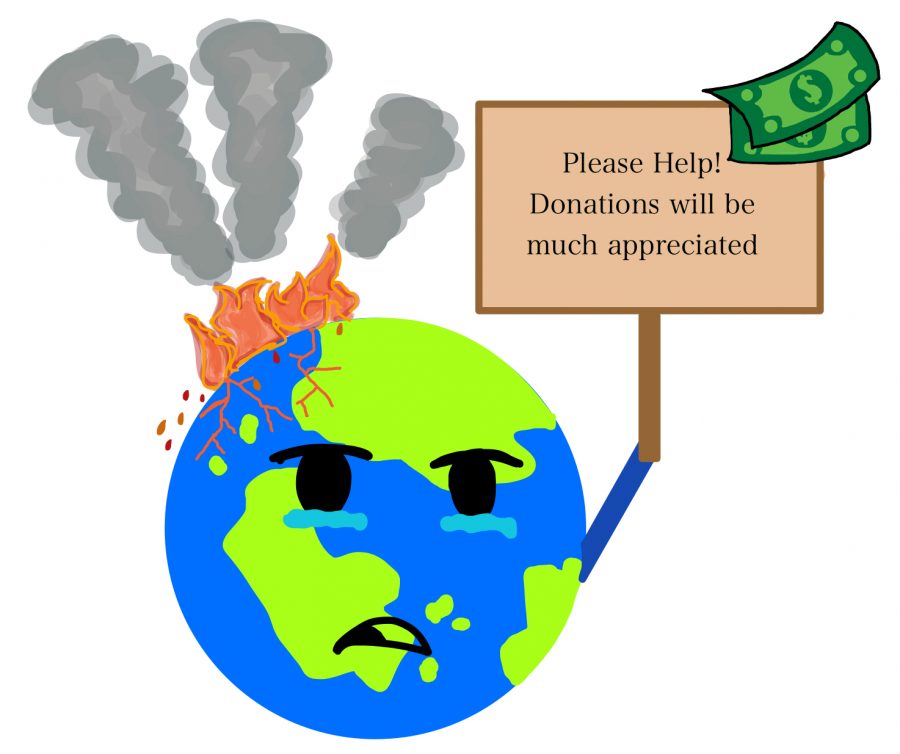Climate Promises Have Been Made; It’s Time To Follow Through
The cartoon depicts Earth’s dire need to receive more climate funding amid rising temperatures
The Glasgow COP26 kicked off October 31, 2021, and ended on November 12 brimming with empty promises and long overdue financial vows; vows of which were promised to less developed countries more than a decade ago.
One of the key issues brought up at Glasgow concerned the 2009 COP’s plan to raise $100 billion for less developed countries to acclimate to clean energy. Twelve years later, not even half of this extravagant sum has been seen by said countries.
Of course, this donation is by no means easy to gather; the global destruction of Covid-19 has greatly dampened efforts to push the focus on climate finances.
COP26’s solution to this financial hole was to “call for developed country Parties to at least double their collective provision of climate finance for adaptation to developing country Parties from 2019 levels by 2025,” as stated by The Climate Finance Delivery Plan.
Possessing a concrete deadline is a reassurance for now, but experience has shown that humanity doesn’t particularly fare well under timely pressures.
If governments weren’t keen on raising the finances when the economy wasn’t straining under a global pandemic, it’s difficult to see how politicians will allow billions of dollars to leave the precious U.S banks.
After a vast economic depression of the pandemic, countries must work to build recovery programs that allow for the economy to heal, and simultaneously for the transition into clean energy.
Climate finance is by far an essential element to global warming mitigation efforts, with large-scale grants representing a sizable portion of the U.S’s financial contributions. These finances are divided into two categories: mitigation and adaptation.
While the control of both are crucial to cooling up the Earth, mitigation could be described as that focal point where all governments should be looking towards.
Adaptation must come after mitigation, and currently, mitigation efforts are still substantially lacking. The arctic is still melting at an alarming rate each year, and greenhouse gas emissions in the oceans haven’t subsided nearly enough for marine ecosystems to rehabilitate themselves.
CO2 emissions have dropped by 6.4% , or 2.3 billion tons, since the Covid-19 pandemic started: a bittersweet improvement on the meager efforts put into place before 2020. Who knew deadly viruses would make the largest dent on anthropogenic environmental disasters?
Humanity can’t rely on global pandemics forever though. Mitigation finances must be put to use through the $100 billion budget, and governments around the world must actually take the money, and put it towards mitigation programs.
The peak of mitigation efforts have taken shape in the form of a potential coal deal. Governments plan to completely eliminate coal-fired plants, which would vastly improve CO2 emissions, and would require a full restructuring of the current transportation and electricity infrastructures.
The loss of coal-fired plants would greatly reduce the production of electricity temporarily, but renewable sources are proving to be more and more reliable.
Geothermal energy continuously uses the circulating heat beneath the Earth to power both heating systems and cooling systems. Although geothermal energy systems are relatively expensive for individual homes to own, these energy plants are significantly less expensive than coal-fired plants.
Large coal-fired plants can reach up to $2 billion to cover safety and production costs while smaller geothermal plants only cost $3,000-$5,000.
Indeed, action is currently being made, but global governments must match the mitigation and adaptation paces with the progression of climate change.
Earth won’t wait for humanity to catch up. Rapid action must take place to truly keep this planet under 2º C of warming.



